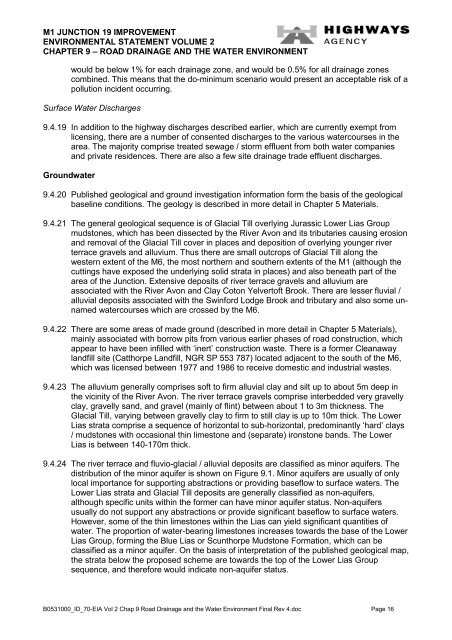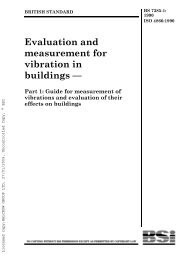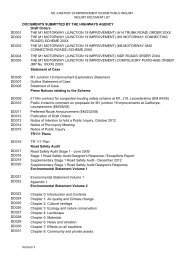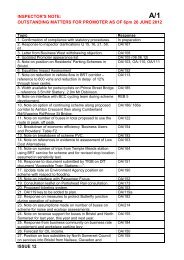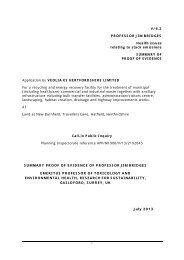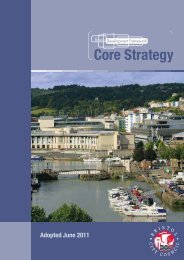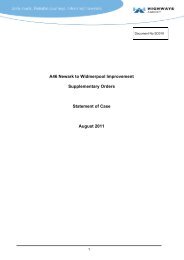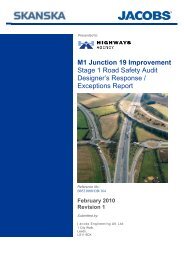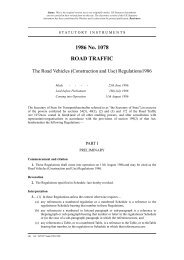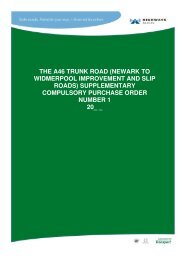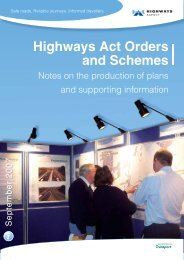Chapter 9: Road drainage and the water environment
Chapter 9: Road drainage and the water environment
Chapter 9: Road drainage and the water environment
Create successful ePaper yourself
Turn your PDF publications into a flip-book with our unique Google optimized e-Paper software.
M1 JUNCTION 19 IMPROVEMENT<br />
ENVIRONMENTAL STATEMENT VOLUME 2<br />
CHAPTER 9 – ROAD DRAINAGE AND THE WATER ENVIRONMENT<br />
would be below 1% for each <strong>drainage</strong> zone, <strong>and</strong> would be 0.5% for all <strong>drainage</strong> zones<br />
combined. This means that <strong>the</strong> do-minimum scenario would present an acceptable risk of a<br />
pollution incident occurring.<br />
Surface Water Discharges<br />
9.4.19 In addition to <strong>the</strong> highway discharges described earlier, which are currently exempt from<br />
licensing, <strong>the</strong>re are a number of consented discharges to <strong>the</strong> various <strong>water</strong>courses in <strong>the</strong><br />
area. The majority comprise treated sewage / storm effluent from both <strong>water</strong> companies<br />
<strong>and</strong> private residences. There are also a few site <strong>drainage</strong> trade effluent discharges.<br />
Ground<strong>water</strong><br />
9.4.20 Published geological <strong>and</strong> ground investigation information form <strong>the</strong> basis of <strong>the</strong> geological<br />
baseline conditions. The geology is described in more detail in <strong>Chapter</strong> 5 Materials.<br />
9.4.21 The general geological sequence is of Glacial Till overlying Jurassic Lower Lias Group<br />
mudstones, which has been dissected by <strong>the</strong> River Avon <strong>and</strong> its tributaries causing erosion<br />
<strong>and</strong> removal of <strong>the</strong> Glacial Till cover in places <strong>and</strong> deposition of overlying younger river<br />
terrace gravels <strong>and</strong> alluvium. Thus <strong>the</strong>re are small outcrops of Glacial Till along <strong>the</strong><br />
western extent of <strong>the</strong> M6, <strong>the</strong> most nor<strong>the</strong>rn <strong>and</strong> sou<strong>the</strong>rn extents of <strong>the</strong> M1 (although <strong>the</strong><br />
cuttings have exposed <strong>the</strong> underlying solid strata in places) <strong>and</strong> also beneath part of <strong>the</strong><br />
area of <strong>the</strong> Junction. Extensive deposits of river terrace gravels <strong>and</strong> alluvium are<br />
associated with <strong>the</strong> River Avon <strong>and</strong> Clay Coton Yelvertoft Brook. There are lesser fluvial /<br />
alluvial deposits associated with <strong>the</strong> Swinford Lodge Brook <strong>and</strong> tributary <strong>and</strong> also some unnamed<br />
<strong>water</strong>courses which are crossed by <strong>the</strong> M6.<br />
9.4.22 There are some areas of made ground (described in more detail in <strong>Chapter</strong> 5 Materials),<br />
mainly associated with borrow pits from various earlier phases of road construction, which<br />
appear to have been infilled with ‘inert’ construction waste. There is a former Cleanaway<br />
l<strong>and</strong>fill site (Catthorpe L<strong>and</strong>fill, NGR SP 553 787) located adjacent to <strong>the</strong> south of <strong>the</strong> M6,<br />
which was licensed between 1977 <strong>and</strong> 1986 to receive domestic <strong>and</strong> industrial wastes.<br />
9.4.23 The alluvium generally comprises soft to firm alluvial clay <strong>and</strong> silt up to about 5m deep in<br />
<strong>the</strong> vicinity of <strong>the</strong> River Avon. The river terrace gravels comprise interbedded very gravelly<br />
clay, gravelly s<strong>and</strong>, <strong>and</strong> gravel (mainly of flint) between about 1 to 3m thickness. The<br />
Glacial Till, varying between gravelly clay to firm to still clay is up to 10m thick. The Lower<br />
Lias strata comprise a sequence of horizontal to sub-horizontal, predominantly ‘hard’ clays<br />
/ mudstones with occasional thin limestone <strong>and</strong> (separate) ironstone b<strong>and</strong>s. The Lower<br />
Lias is between 140-170m thick.<br />
9.4.24 The river terrace <strong>and</strong> fluvio-glacial / alluvial deposits are classified as minor aquifers. The<br />
distribution of <strong>the</strong> minor aquifer is shown on Figure 9.1. Minor aquifers are usually of only<br />
local importance for supporting abstractions or providing baseflow to surface <strong>water</strong>s. The<br />
Lower Lias strata <strong>and</strong> Glacial Till deposits are generally classified as non-aquifers,<br />
although specific units within <strong>the</strong> former can have minor aquifer status. Non-aquifers<br />
usually do not support any abstractions or provide significant baseflow to surface <strong>water</strong>s.<br />
However, some of <strong>the</strong> thin limestones within <strong>the</strong> Lias can yield significant quantities of<br />
<strong>water</strong>. The proportion of <strong>water</strong>-bearing limestones increases towards <strong>the</strong> base of <strong>the</strong> Lower<br />
Lias Group, forming <strong>the</strong> Blue Lias or Scunthorpe Mudstone Formation, which can be<br />
classified as a minor aquifer. On <strong>the</strong> basis of interpretation of <strong>the</strong> published geological map,<br />
<strong>the</strong> strata below <strong>the</strong> proposed scheme are towards <strong>the</strong> top of <strong>the</strong> Lower Lias Group<br />
sequence, <strong>and</strong> <strong>the</strong>refore would indicate non-aquifer status.<br />
B0531000_ID_70-EIA Vol 2 Chap 9 <strong>Road</strong> Drainage <strong>and</strong> <strong>the</strong> Water Environment Final Rev 4.doc Page 16


